Welcome to our comprehensive care and growth guide for Vesicularia Dubyana, also known as java moss.
This guide is specifically tailored to beginner gardeners who are venturing into the world of growing freshwater aquarium plants.
Whether you’re new to gardening or an experienced hobbyist looking to add a touch of green to your tank, we’ve covered you with all the information you need to care for and nurture this beautiful aquatic plant successfully.
Java moss, scientifically known as Vesicularia Dubyana, is a versatile and hardy plant that can thrive in a variety of conditions.
Its lush green color and delicate fronds make it a popular choice among aquarists looking to create lush and natural-looking aquarium landscapes.
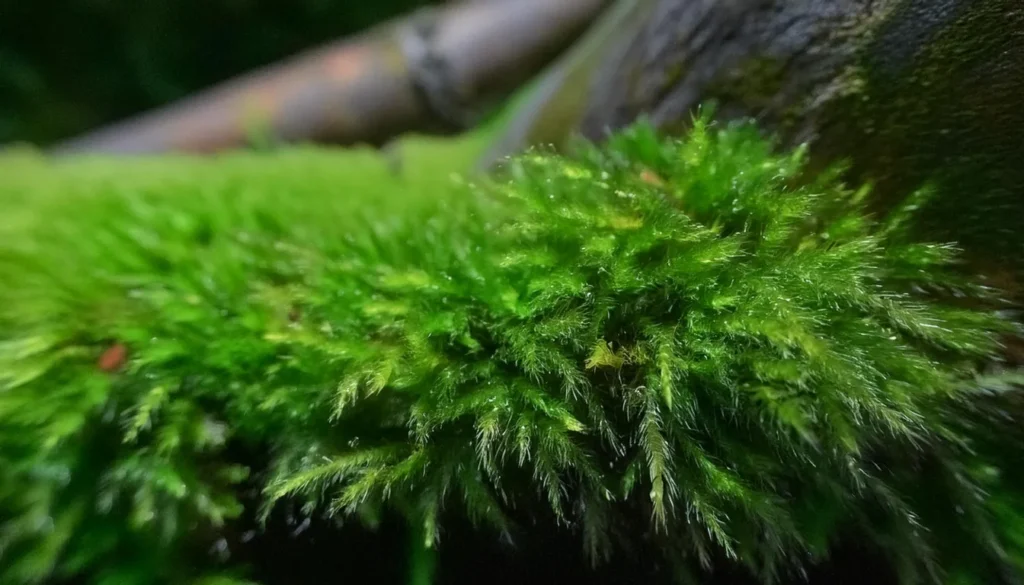
But caring for Vesicularia Dubyana requires a basic understanding of its lighting, temperature, and water requirements.
In this guide, we’ll walk you through everything you need to know about caring for Vesicularia Dubyana.
From understanding its natural habitat and origin to providing the right lighting and temperature parameters, we’ll cover all the essential aspects of this plant’s care.
We’ll discuss suitable tank mates, nutritional needs, propagation techniques, and the many benefits of planting Vesicularia Dubyana in your aquarium.
Key Takeaway
- Learn how to care for Vesicularia Dubyana, also known as java moss, in your freshwater aquarium.
- Understand its lighting, temperature, and water requirements for optimal growth.
- Discover suitable tank mates, propagation techniques, and the benefits of planting Vesicularia Dubyana in your aquarium.
- Gain the knowledge and confidence to successfully cultivate and maintain this versatile aquatic plant.
- Enhance the aesthetic appeal of your aquarium while providing natural cover and shelter for your fish and fry.
Quick Stats
| Attribute | Details |
| Scientific Name | Vesicularia dubyana |
| Common Name | Java Moss |
| Origin | Southeast Asia, particularly found in Java, Indonesia |
| Height | 3-10 cm (1.2-4 inches) |
| pH Range | 5.0 – 7.5 |
| CO2 Requirement | Low to Medium |
| Growth Rate | Moderate to Fast |
| Care Level | Easy |
| Color Form | Dark green |
| Water Conditions | 18-26°C (64-79°F), adaptable to various water parameters |
| Max Size | Typically remains within the stated height range |
| Lighting | Low to Moderate |
| Supplements | Minimal; benefits from occasional liquid fertilization |
| Placement | Foreground to Midground |
| Propagation | Through division or by attaching small portions to surfaces |
What Is Vesicularia Dubyana (java moss)?
In this section, we will provide an overview of Vesicularia Dubyana, commonly known as java moss.
Java moss, scientifically named Vesicularia Dubyana, is a popular freshwater aquarium plant cherished for its lush and vibrant appearance.
Its intricate and delicate fronds create a unique texture that adds depth and beauty to aquatic landscapes.
Unlike other aquatic mosses, Vesicularia Dubyana has a sprawling growth pattern that makes it an excellent choice for creating natural aquascapes. This versatile plant can attach to various surfaces, such as driftwood, rocks, and substrate, transforming ordinary features into captivating focal points.
Natural Habitat And Origin
- Vesicularia Dubyana, also known as java moss, thrives in its natural habitat along riverbanks, streams, and the forest floor. It is typically found above the surface, growing on rocks and other surfaces. With its ability to form dense mats, java moss contributes to the biodiversity of tropical countries such as India, Indonesia, and the Philippines.
- Java moss plays a crucial role in freshwater ecosystems, providing shelter and hiding spots for small fish and invertebrates. Its presence on riverbanks and streams helps to stabilize the soil and prevent erosion. Java moss forms lush carpets on the forest floor, creating a captivating and vibrant landscape.
- The geographical distribution of Vesicularia Dubyana highlights its preference for warm climates, making it a popular choice for aquarists in tropical regions. Its ability to adapt to various environmental conditions has also made it a beloved plant among beginner gardeners, as it can thrive in a range of tank setups.
Physical Characteristics
- One of the distinct physical characteristics of Vesicularia Dubyana, commonly known as java moss, is its unique stem structure. The stems of java moss are slender and covered in small oval-shaped leaves. These leaves give the moss a lush and vibrant appearance, adding beauty to any aquarium. The fine texture and intricacy of the leaves create an appealing visual contrast against other plants and decorations in the tank.
- It’s important to note that the physical appearance of Vesicularia Dubyana may vary depending on whether it is grown underwater or on land. Underwater-grown java moss develops dense, bushy clusters that provide ideal hiding spaces for fish fry and shrimp. On the other hand, land-grown java moss tends to have a sparser growth pattern, resulting in a more delicate and wispy appearance.
- Vesicularia Dubyana attaches itself to surfaces using specialized structures called rhizoids. These root-like extensions enable the moss to anchor itself securely to rocks, driftwood, or substrate. Additionally, the rhizoids play a vital role in absorbing nutrients from the water, ensuring the proper growth and development of java moss in your aquarium.
Lighting Demands Of The Plant
- When it comes to the lighting demands of Vesicularia Dubyana, also known as java moss, it is considered a low-light plant. This means that it can thrive in low to moderate lighting conditions, making it an excellent choice for beginner gardeners or those with aquariums that do not receive direct sunlight.
- The ideal light levels for the growth of Vesicularia Dubyana are typically around 1-2 watts per gallon or 0.25-0.5 watts per liter. It is important to note that providing too much light can actually be detrimental to the plant, as it can encourage the growth of unwanted algae.
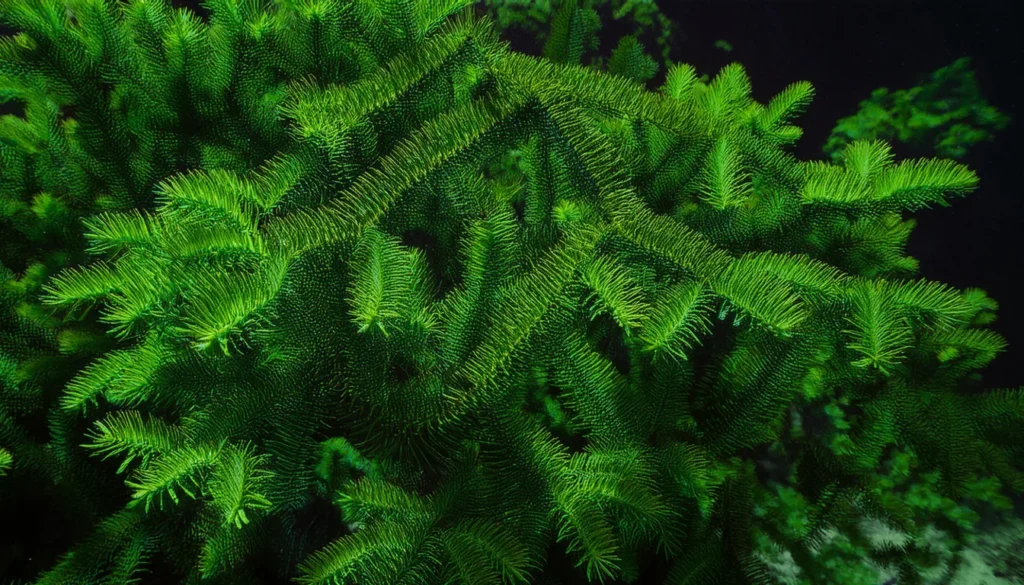
Temperature Parameters
- Proper temperature is crucial for the healthy growth of Vesicularia Dubyana, also known as java moss. This versatile aquatic plant is capable of adapting to a wide range of temperatures in tropical aquariums. To ensure optimal growth, it is important to maintain a stable temperature within the recommended range.
- Vesicularia Dubyana thrives in temperatures ranging from **68°F to 82°F** (20°C to 28°C). This temperature range simulates its natural habitat in warm, tropical countries. It is essential to monitor and regulate the temperature in your aquarium to create a comfortable environment for java moss.
- Maintaining a stable temperature is crucial as sudden fluctuations can cause stress and negatively impact the health of Vesicularia Dubyana. Use a reliable aquarium thermometer to monitor the temperature regularly and make adjustments as needed.
- Extreme temperature variations, especially prolonged exposure to temperatures outside the recommended range, can lead to stunted growth and the decline of java moss. Additionally, temperature extremes can create an unfavorable environment for fish and other aquarium inhabitants. Therefore, it is vital to choose suitable tank mates that can tolerate the temperature preferences of **Vesicularia Dubyana**.
Optimal Water Condition For Growth
- pH Levels: The pH level of the water plays a crucial role in the overall health of Vesicularia Dubyana. This aquatic plant thrives in a slightly acidic to neutral pH range, typically between 6.0 and 7.5. It is important to regularly monitor and adjust the pH level of your aquarium to ensure it remains within the preferred range for java moss. This can be achieved through the use of appropriate water conditioners or pH-adjusting products.
- Water Flow: Proper water flow is vital for Vesicularia Dubyana as it helps simulate its natural habitat and promotes healthy growth. Java moss prefers gentle to moderate water movement, which allows the plant to receive an adequate supply of nutrients while preventing excessive debris buildup. Consider using a filter or adjusting the flow rate of your aquarium’s water pump to maintain the ideal water flow for Vesicularia Dubyana.
- Water Consistency: Consistency is key in maintaining optimal water conditions for Vesicularia Dubyana. Java moss is sensitive to sudden changes in water parameters, so providing a stable environment for the plant is important. Avoid drastic fluctuations in temperature, pH levels, and other water parameters to ensure the health and well-being of Vesicularia Dubyana. Regularly monitor water parameters and make gradual adjustments when necessary.
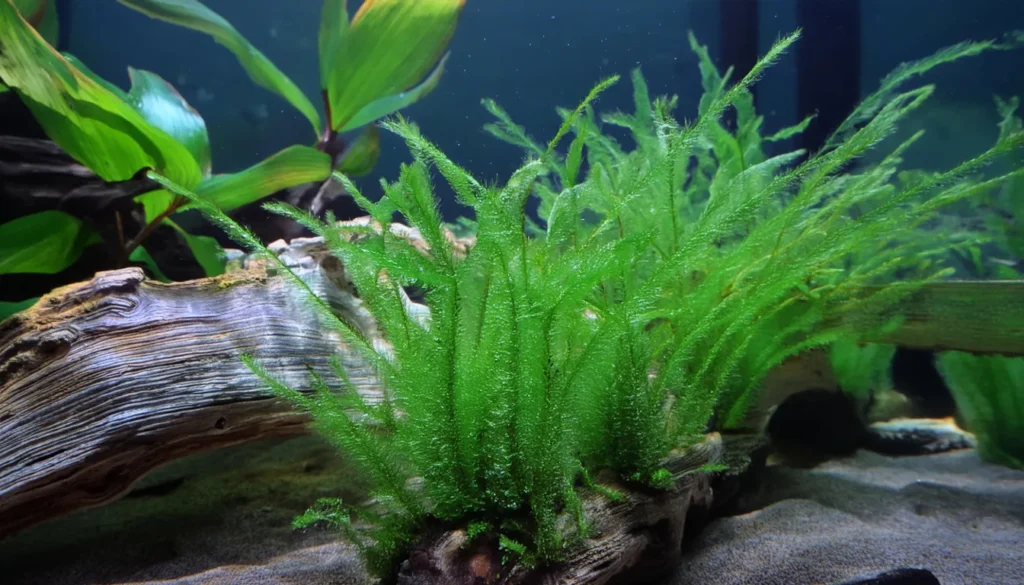
Placement Option In Tank
- Attaching to Walls: One popular placement option for Vesicularia Dubyana is attaching it to the walls of your aquarium. This creates a visually appealing “wall of moss” effect that adds depth and texture to your tank. To attach java moss to the walls, you can use fishing lines, mesh, or suction cups. Drape the moss over the desired area and secure it in place using your chosen method. Ensure that the moss is tightly attached to prevent it from floating around or getting tangled with other aquarium inhabitants.
- Creating a Carpet-Like Effect: Another popular placement option for Vesicularia Dubyana is creating a carpet-like effect on the substrate of your aquarium. This involves spreading a dense layer of java moss across the bottom of the tank to create the appearance of a lush green carpet. To achieve this, ensure that the substrate is a suitable texture for java moss attachment. Finer substrates like sand or specialized carpeting substrates work best for maintaining the desired placement.
- Benefits of Vesicularia Dubyana Placement: There are several benefits to incorporating Vesicularia Dubyana as a decorative element in your tank. Not only does it create a visually striking appearance, but it also provides numerous hiding spots and natural cover for fish and fry. The dense growth pattern of java moss offers a secure and sheltered environment for small aquatic organisms, fostering their well-being and overall tank harmony.
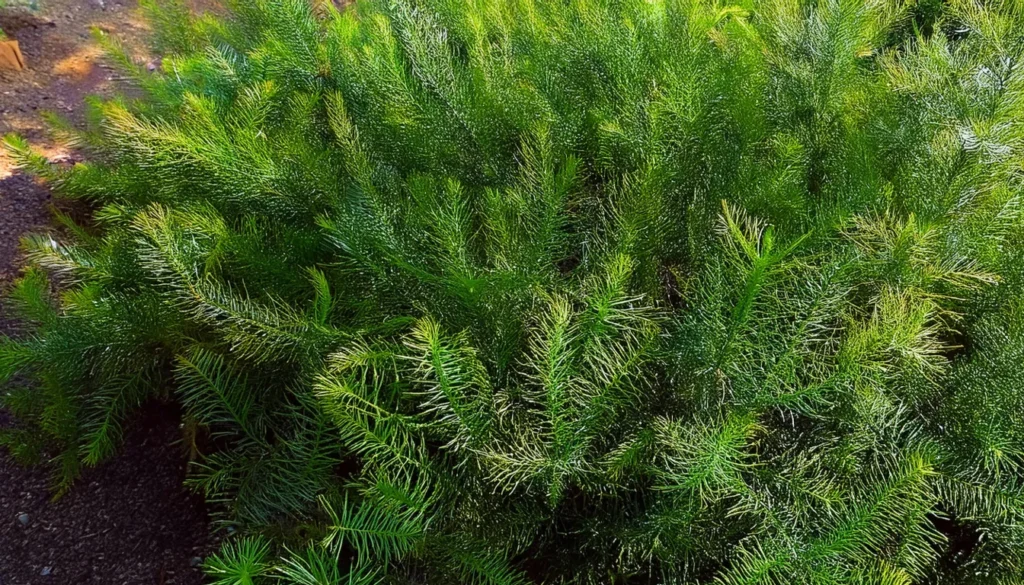
Substrate Requirement
- Coconut fiber: Coconut fiber provides excellent moisture retention and promotes root formation for java moss. It also offers a natural look to your aquarium.
- Aquarium soil: Specialized aquarium soil releases essential nutrients to the root system of Vesicularia Dubyana, facilitating healthy growth.
- Aquarium gravel: Gravel with a small grain size allows sufficient water circulation and prevents the moss from waterlogging.
- Aquarium sand: Sand is another substrate option that can accommodate Vesicularia Dubyana. However, ensure that the sand is fine-grained and does not compact excessively.
Recommended Tank Size
- When it comes to housing Vesicularia Dubyana or java moss, choosing the right tank size is crucial for this freshwater aquarium plant’s optimal growth and spread. **Vesicularia Dubyana tank size**, tank capacity, and space requirements are important considerations in creating a suitable environment for java moss to thrive.
- Due to its sprawling growth habit, Vesicularia Dubyana requires ample space to spread and attach itself to various surfaces. A larger tank size provides more room for Java moss to expand, resulting in denser and more visually appealing growth. It also allows for better water circulation and reduces the risk of overcrowding, which can lead to nutrient deficiency and hinder the plant’s overall health.
- For tanks containing only Vesicularia Dubyana, a tank capacity of 10 gallons or more is recommended to accommodate the plant’s size and growth pattern. This size ensures that java moss has sufficient space to thrive and prevents it from overshadowing other tank inhabitants.
RELATED: A Comprehensive Guide To Plant Rotala Indica In Aquascape
Suitable Tank Mates For Vesicularia Dubyana (java moss)
In order to create a harmonious and thriving aquarium environment, it’s important to carefully select compatible tank mates for your Vesicularia Dubyana (java moss).
Choosing species that can peacefully coexist with java moss will enhance the visual appeal of your aquarium and contribute to the overall well-being of your aquatic ecosystem.
When selecting tank mates, it’s essential to consider factors such as temperament, size, and water requirements.
For fish compatibility, there are several species that are known to be compatible with Vesicularia Dubyana.
Some suitable tank mates for java moss include:
- Neon Tetras
- Ember Tetras
- Cherry Barbs
- Pygmy Corydoras
- Otocinclus Catfish
- Guppies
- Danios
- Cherry Shrimp
- Amano Shrimp
- Ghost Shrimp
- Red Crystal Shrimp
- Bamboo Shrimp

Nutritional Needs Of Vesicularia Dubyana (java moss)
In order to ensure the healthy growth and development of Vesicularia Dubyana, it is important to understand its nutritional needs.
Like any other aquatic plant, Java moss relies on nutrient uptake to thrive in your freshwater aquarium.
- Nutrient uptake: Vesicularia Dubyana absorbs nutrients from the surrounding water through its leaves and stems. It utilizes essential macronutrients such as nitrogen, phosphorus, and potassium and micronutrients like iron, magnesium, and calcium.
- Fertilization: While Vesicularia Dubyana can survive in nutrient-deficient environments, providing additional fertilization can greatly enhance its growth and overall appearance. You can introduce fertilizers for aquatic plants into your aquarium to ensure a balanced nutrient supply. These fertilizers typically contain a range of essential nutrients that are readily absorbed by java moss.
- CO2 supplementation: Carbon dioxide (CO2) is another crucial nutrient required for the growth of Vesicularia Dubyana. While java moss can thrive in low CO2 environments, supplementing with CO2 can promote healthier and faster growth. CO2 supplementation can be achieved by using CO2 injection systems or adding liquid carbon sources.
| Nutrient | Importance | Sources |
| Nitrogen | Essential for overall growth and chlorophyll production. | Water column, fish waste, fertilizers. |
| Phosphorus | Crucial for energy transfer and cell division. | Water column, fish waste, fertilizers. |
| Potassium | Supports various physiological processes. | Water column, fish waste, fertilizers. |
| Iron | Key for chlorophyll production and overall plant health. | Water column, supplements, substrate. |
| Magnesium | Essential for chlorophyll synthesis and enzyme function. | Water column, supplements, substrate. |
| Calcium | Important for cell wall structure and growth. | Water column, supplements, substrate. |
Essential Plant Maintenance
- Trimming Techniques: To maintain the desired shape and prevent overgrowth, it is important to trim your java moss regularly. Trimming not only helps control the size of Vesicularia Dubyana but also promotes healthier growth. When trimming, use sharp pruning shears to cut away any excess or unwanted portions of the moss. Focus on removing any dead, brown, or decaying sections of the plant to maintain its overall health and appearance.
- Algae Control: Algae growth can be a common issue in freshwater aquariums, and java moss is not exempt from this. To effectively control algae in your tank, it is important to take preventive measures. Ensure your aquarium receives proper lighting, as excessive light can promote algae growth. Implement a regular cleaning routine, removing any algae that may appear on the Vesicularia Dubyana or other surfaces in the tank. Additionally, consider adding algae-eating fish or shrimp to help keep the algae population under control.
- Water Changes: Regular water changes are essential for maintaining the overall health and well-being of Vesicularia Dubyana. Changing a portion of the water in your aquarium helps remove any accumulated toxins, excess nutrients, and algae spores that can lead to algae blooms. As a general guideline, perform a weekly water change of around 20-25% of the total tank volume. This will help ensure a stable and clean environment for your java moss and other tank inhabitants.
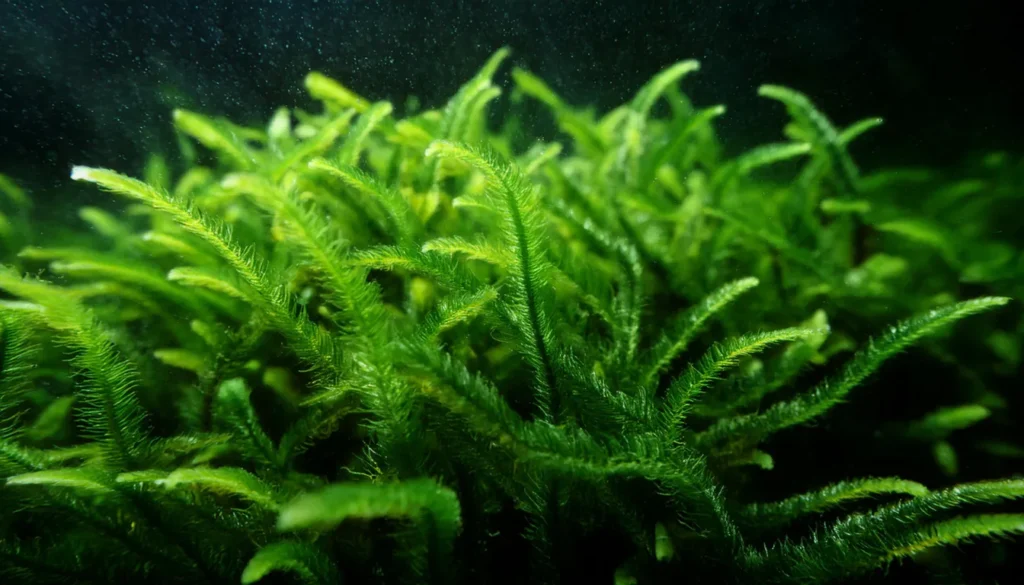
Cultivating Vesicularia Dubyana (java moss) At Home
- To begin cultivating Vesicularia Dubyana, you will need to set up a suitable aquarium environment. Start by selecting a tank with adequate capacity to accommodate the growth of java moss. Consider the space requirements and the size of your other tank inhabitants.
- Next, choose a substrate that is conducive to Vesicularia Dubyana’s growth. Java moss can be attached to various surfaces, such as rocks, driftwood, or even mesh. Attach the java moss to your chosen surface using cotton thread or fishing line, allowing it to anchor and grow over time.
- Java moss is a low-light plant that can thrive even in low-intensity illumination. However, it’s important to ensure that the lighting is consistent and does not cause excessive algae growth. For the best results, consider using LED lights or fluorescent bulbs with a color temperature of around 6500K.
- Water temperature is another crucial factor in cultivating Vesicularia Dubyana. This plant adapts to a wide range of temperatures and can thrive in tropical and cooler aquariums. Aim for a temperature range of 68-82°F (20-28°C) to create an ideal environment for the growth of java moss.
- Maintaining the right water conditions is essential for the healthy growth of Vesicularia Dubyana. Aim for a slightly acidic to neutral pH level (6.0-7.5) and ensure proper water flow to prevent stagnant areas. Consistency in water parameters and regular water changes will help provide optimal conditions for Java moss.
- As for fertilization, java moss is not a heavy feeder and can obtain nutrients from the water column and substrate. However, providing supplementary nutrients through liquid or substrate fertilizers can promote lush growth and help maintain the vibrant green color of Vesicularia Dubyana.
Plant Propagation Tips
In order to expand your Vesicularia Dubyana, or java moss, collection, it is important to understand the various propagation techniques.
By successfully propagating this aquatic moss, you can create a lush and vibrant appearance in your aquarium.
In this section, we will explore two common methods for Vesicularia Dubyana propagation: plant division and attaching new growth to various surfaces.
Plant Division
- Gently remove a healthy portion of java moss from your aquarium.
- Using clean scissors, carefully divide the moss into smaller sections. Ensure that each section has enough size and foliage to thrive on its own.
- Attach each divided section to a desired surface, such as rocks or driftwood, using a fishing line or cotton thread.
- Place the newly divided sections back into your aquarium and monitor their growth over time.
RELATED: Unraveling The Splendor Of Rotala Wallichii In Aquascapes
Attaching New Growth to Various Surfaces
- Identify healthy portions of Vesicularia Dubyana that have new growth emerging.
- Detach the new growth from the parent plant by carefully cutting or pulling it away.
- Secure the new growth to the desired surface using a fishing line or cotton thread, ensuring that it is firmly attached.
- Place the newly attached growth into your aquarium and provide suitable conditions for its development.

Benefits Of Planting Vesicularia Dubyana (java moss)
- Planting Vesicularia Dubyana, commonly known as java moss, in your freshwater aquarium offers a multitude of benefits. Not only does it add a beautiful touch to your tank’s aesthetic appeal, but it also provides natural cover and shelter for your fish and their fry. With its dense growth pattern, java moss creates a safe and inviting environment, making your fish feel secure and reducing stress levels.
- One of the advantages of Vesicularia Dubyana is its ability to contribute to improved water quality. This low-light plant helps to regulate and stabilize the aquarium ecosystem by absorbing excess nutrients and minimizing the scope for algae growth. By doing so, java moss promotes healthier water conditions and maintains a balanced ecosystem for your aquatic inhabitants.
- Vesicularia Dubyana is well-suited for beginner gardeners due to its low-maintenance nature. It thrives in a variety of lighting conditions, making it ideal for tanks with lower light levels. Java moss is adaptable and can tolerate a wide range of temperatures, providing beginners with more flexibility in managing their aquarium’s environment.
Conclusion
We hope this comprehensive guide on the care and growth of Vesicularia Dubyana, also known as java moss, has been helpful to beginner gardeners.
Throughout this article, we have discussed various aspects of growing java moss in your freshwater aquarium, from its natural habitat and physical characteristics to its lighting, temperature, and water requirements.
By providing optimal care, you can ensure the health and vitality of Vesicularia Dubyana in your aquarium.
Maintaining suitable lighting conditions, temperature parameters, and water consistency will promote this versatile plant’s growth and overall well-being. Proper placement and substrate choice are also crucial for successful cultivation.
Frequently Asked Questions
What Are The Nutritional Needs Of Vesicularia Dubyana?
Vesicularia Dubyana obtains nutrients from the water column and can benefit from regular fertilization and, in some cases, CO2 supplementation.
Providing adequate nutrition is crucial for its healthy development.
How Should Vesicularia Dubyana Be Maintained?
Maintenance practices for Vesicularia Dubyana include regular trimming to prevent overgrowth, controlling algae, and performing routine water changes.
These practices contribute to the health and vitality of java moss.
How Can Vesicularia Dubyana Be Cultivated At Home?
Vesicularia Dubyana can be cultivated at home by setting up an aquarium with suitable lighting, temperature, and water conditions.
Beginner gardeners can follow aquascaping techniques and general gardening advice to achieve successful cultivation.
What Are The Plant Propagation Tips For Vesicularia Dubyana?
Vesicularia Dubyana can be propagated through various techniques, such as plant division and attaching new growth to different surfaces.
Encouraging carpeting spread can create a lush and vibrant appearance in the aquarium.
What Are The Benefits Of Planting Vesicularia Dubyana In The Aquarium?
Planting Vesicularia Dubyana in the aquarium enhances the aesthetic appeal of the tank, provides natural cover and shelter for fish and fry, and contributes to improved water quality.
It is also suitable for beginner gardeners due to its low-light requirements and easy care.
- Unveiling The Wonders Of Riccia Fluitans In Aquascapes - August 7, 2024
- Vallisneria Gigantea Var. Guide To Care And Cultivation At Home - July 31, 2024
- Vesicularia Dubyana Care & Growth Guide Tips For Beginner Gardeners - July 30, 2024
